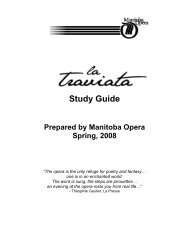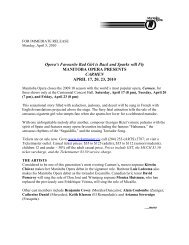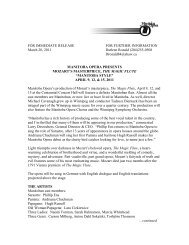You also want an ePaper? Increase the reach of your titles
YUMPU automatically turns print PDFs into web optimized ePapers that Google loves.
The Roma or Gypsies<br />
RELATED TOPICS OF STUDY<br />
<strong>Carmen</strong> and Gypsy History<br />
<strong>Carmen</strong> and her friends are Gypsies, a word used to describe an ethnic group of people known for<br />
their music, fortunetelling, and nomadic lifestyle. Many misconceptions of Gypsies exist, arising<br />
from ignorance and misunderstanding. Some of <strong>Carmen</strong>'s characteristics are based on negative<br />
Gypsy stereotypes, but other things are true.<br />
Gypsies<br />
"Gypsy" is actually a derogatory (insulting) word. The group of people it refers to are more<br />
accurately called Roma, and the language they speak is Romanes, or Romani. There are four<br />
Roma tribes, or nations (the Kalderash, the Machavaya, the Lovari, and the Churari), plus many<br />
other smaller groups (such as the Sinti, the Luri, and the Xoraxai). Most Roma refer to<br />
themselves by their tribal name or by "Rom" or "Roma", meaning "Man" and "People".<br />
There are approximately 12 million Roma living in several nations around the<br />
world, but it is hard to get an exact number since they are not usually included in<br />
official census counts. Roma tend to live in their own communities, separate from<br />
the gajikané (foreign) society around them. Centuries of discrimination and ethnic<br />
hatred have made them suspicious of outsiders, and they fear that integrating<br />
into gajikané society will cause them to lose their unique cultural identity.<br />
Over the centuries, Roma have spread into many different countries worldwide and have adapted<br />
to varying degrees to their different cultural environments. For this reason, there is no universal<br />
Roma culture, and there are many differences; what is "true Roma" to one group may be "gadjé",<br />
or foreign, to another. However, there are some things characteristic of all Roma, for example:<br />
loyalty to family, belief in predestiny, and adaptibility to changing conditions.<br />
Origins<br />
Although the words "Roma" and "Romani" look like they are related to "Rome" and "Roman", the<br />
Roma did not come from Italy. Scholars have traced the Roma's ethnic heritage to India through<br />
clues in the language. Romani is an Indo-Aryan language whose origin is ancient Punjabi, or<br />
Hindi, an Indian language. Today there are many spoken<br />
dialects of Romani, but no standardized written language.<br />
There were several waves of migrations in the Roma's<br />
history. They first left India about 1000 years ago, probably<br />
due to a war that the Hindu peoples were fighting with the<br />
Muslims. The ethnically mixed army spread out along the<br />
territorial limits of Islam, so they moved into Persia (today's<br />
Iran) and reached southeastern Europe around 1300. The<br />
next major migration occurred in the 19th and early 20th<br />
century, when Roma moved from Europe to the Americas<br />
after the abolition of<br />
Romani slavery.<br />
Clothing<br />
Roma women in the stories and movies usually wear a long colorful skirt, a flower in their hair,<br />
and lots of gold jewelry. This is actually not far from the truth. A Roma woman will grow her hair<br />
long, and it is usually worn braided until she is married. Once she is married, she will cover her<br />
hair with a diklo, or head scarf, that she will always wear when she is in public.<br />
Roma women wear long skirts because of strong ideas about cleanliness and uncleanliness. The<br />
lower half of a woman's body is associated with menstruation, and is therefore viewed as<br />
24








